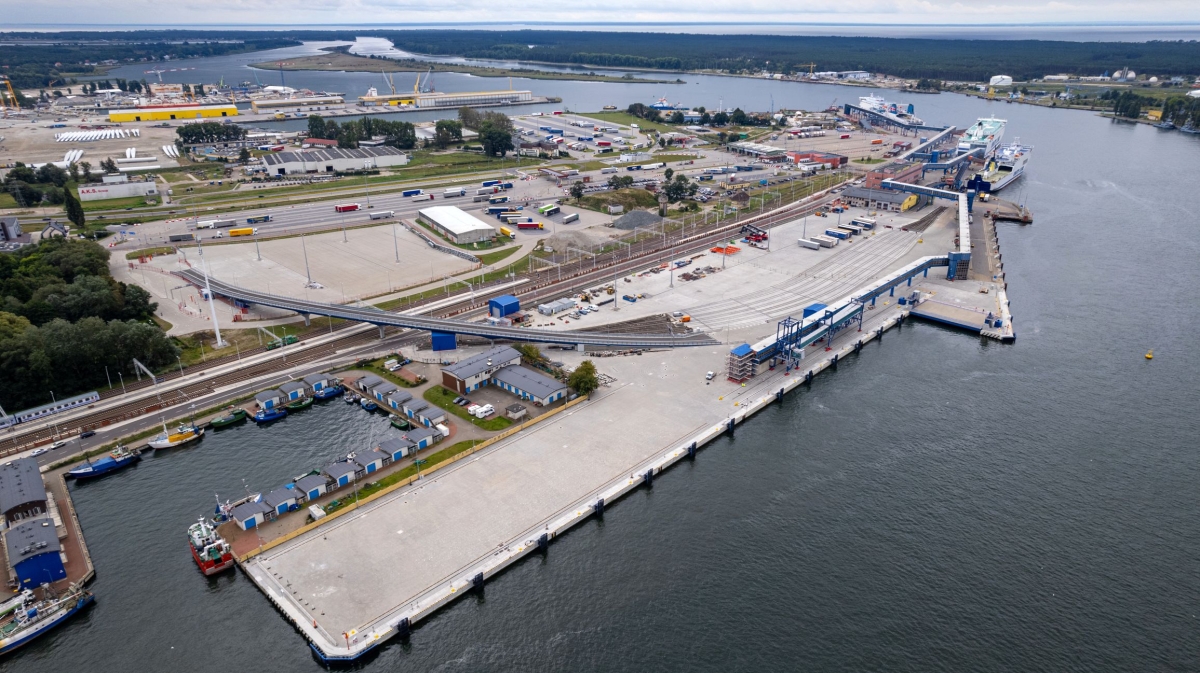
In 2024, the Świnoujście Ferry Terminal processed over 5.8 million tons of breakbulk cargo, slightly more than in 2023. Intermodal handling and transport of railway wagons were resumed. Over 433,000 trucks boarded ferries.
The 2024 cargo statistics for the terminal show a slight increase in the amount of breakbulk cargo and a steady number of freight units: trucks, trailers, and wagons. Last year, ferries traveling from Świnoujście to Scandinavia transported 433,281 trucks (down by 0.7% from 436,185 in 2023), 25,998 trailers (up 11.8% from 23,255), and 80 railway wagons, thanks to the resumption of intermodal handling after a six-year break.
"It is worth noting the end of the downward trend in breakbulk ferry traffic that had been ongoing since 2022. In 2024, there was a 0.7% increase," said Weronika Gocłowska, spokesperson for the Szczecin and Świnoujście Seaport Authorities, in an interview with PAP.
ZMPSiŚ is the main shareholder in the Świnoujście Ferry Terminal company. Last year, 5,865,779 tons (net) of road freight were handled at TPŚ, compared to 5,824,215 tons in 2023. In 2022, ferries transported 6,564,400 tons, and the year before, 6,733,897 tons. These figures reflect the crisis in transport and freight services after the pandemic and the war in Ukraine, but ferry operators and the entire maritime industry are now seeing a slight "recovery" and hope for economic revival.
"In 2025, we expect a 6% increase in ferry cargo traffic," Gocłowska emphasized.
She also noted that TPŚ served 4.6% more passengers in 2024 than in 2023. However, the number of passenger cars traveling on ferries between Świnoujście and Scandinavia decreased by 4.9%.
In 2024, 609,187 passengers (plus more than 375,000 drivers) were registered. In 2023, there were 582,222 passengers, but nearly 460,000 drivers. The number of personal cars transported in 2024 was 249,180, compared to 262,156 the previous year. A total of 802 buses crossed the Baltic, which is a decrease of 10.7% compared to 2023 when there were 1,011.
TPŚ operates more than ten sailings per day, with vessels from three operators docking at the ferry terminal. Unity Line ferries (owned by PŻM and Euroafrica) travel to Ystad and Trelleborg, Polferries (Polska Żegluga Bałtycka) operates routes to Ystad, and TT Line (a German company) operates on the Świnoujście-Trelleborg route.
In 2024, Finnlines launched a new route from Świnoujście to Malmö, offering daily sailings, but not from TPŚ, instead from the nearby private EuroTerminal.
Polish shipowners are eager to increase their share of the ferry transport market in the Baltic. In July 2024, Polferries launched the "Varsovia" LNG-powered ferry, the largest Ro-Pax (car-passenger) vessel on the route to Ystad. It is 216 meters long, 28 meters wide, and has 3,775 meters of cargo line. It can carry 920 passengers, 160 trucks, and 200 cars.
"We plan to introduce a new Unity Line vessel on the Trelleborg route in September," Gocłowska reported.
The ferry, named Jantar, is 195.6 meters long, 32.2 meters wide, and has 4,100 meters of cargo line. It is equipped with LNG-powered engines, has a top speed of 19 knots, and can carry 400 passengers.
Thanks to investments made in recent years, the Świnoujście port is prepared for intermodal transport and can accommodate ferries up to 270 meters long. The quay has been modernized and extended, and new technical infrastructure, maneuvering areas, and better road and rail access have been established. In December 2024, a pilot intermodal trailer cargo was handled by M/F Polonia, a Unity Line vessel.
The reopening of the rail corridor between Poland and Scandinavia and the expansion of infrastructure provide an opportunity for the development of TPŚ and the nearby Swedish port of Ystad, where ferries up to 250 meters long can dock. Erik Eskling Hansen, Business Developer at Port Ystad, told PAP that "the volume of traffic in the service to Poland" in 2024 was over 200,000 trailers. While down from previous years, there is a growth trend compared to 2021-2023. Eskling Hansen emphasized that the ferry transport market saw declines during the "post-pandemic" period.
"In the past few years, we observed stagnation in the market, mainly due to economic slowdown, particularly in the construction sector. However, recently we have noticed signs of market recovery, and I hope this trend continues," he said.
Port Ystad's plans for 2025 include not only "increasing the volume of existing clients" and "attracting new ferry lines" but also the development of offshore and bulk cargo areas. To handle these, the Swedish port has ordered a new hydraulic crane, which is scheduled for delivery in the second quarter of this year.
Eskling Hansen pointed out that on the MF Polonia, which operates daily between Świnoujście and Ystad, there are 600 meters of railway tracks (six tracks ranging from 80 to 140 meters in length), allowing for the transport of "the equivalent of a typical Polish freight train." The ability to transport wagons (e.g., with containers) benefits ports, ferry operators, and carriers.
"This meticulously designed system guarantees quick and efficient loading and unloading, increasing safety while reducing logistical costs. Furthermore, it is an extremely eco-friendly solution, as it significantly reduces CO2 emissions and lessens the burden on road infrastructure," concluded Hansen.
Port Ystad handles about 3,700 ferry calls annually, transporting 2.3 million passengers.
The ferry connection between Świnoujście and Ystad was briefly launched in 1964 by a Danish operator. Since 1967, regular ferries have operated from Poland to Sweden, with the "Gryf" ferry purchased by the Polish Maritime Shipping Company. In the 1970s, the ferry terminal was expanded, and new vessels were introduced, with Polska Żegluga Bałtycka launching a route to Copenhagen. In the late 1980s and early 1990s, a new ferry terminal was built, with three additional docking positions, a passenger terminal, and galleries for passengers.
tma/ mick/ jpn/


